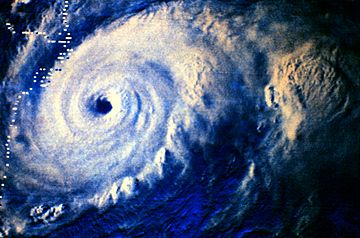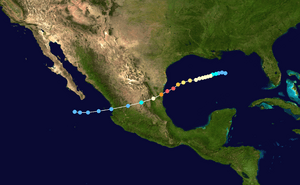Hurricane Anita facts for kids
| Category 5 major hurricane (SSHWS/NWS) | |

Hurricane Anita on September 2, 1977, approaching the Gulf coast of Mexico.
|
|
| Formed | August 29, 1977 |
|---|---|
| Dissipated | September 4, 1977 |
| Highest winds | 1-minute sustained: 175 mph (280 km/h) |
| Lowest pressure | 926 mbar (hPa); 27.34 inHg |
| Fatalities | 11 direct |
| Areas affected | Northeastern Mexico |
| Part of the 1977 Atlantic hurricane season | |
Hurricane Anita was the only very strong hurricane during the 1977 Atlantic hurricane season. It hit Mexico as a Category 5 hurricane, which is the strongest kind. Even though it was so powerful, the exact amount of damage it caused is not fully known. Sadly, Hurricane Anita caused the deaths of 11 people in Mexico.
Contents
How Hurricane Anita Formed and Grew
Starting as a Tropical Wave
Hurricane Anita began as a "tropical wave" on August 16. A tropical wave is like a ripple in the air that can sometimes grow into a storm. This wave moved west from the coast of Africa. After about a week, it started to gather clouds.
On August 27, the wave changed direction. It moved northwest over Cuba. The clouds connected to it were over the Bahamas and Florida.
Becoming a Tropical Depression
The tropical wave soon moved across Florida. It then entered the Gulf of Mexico. In the Gulf, the weather conditions were perfect for a storm to form. This was because of a weather system called an "anticyclone." An anticyclone helps storms grow stronger.
The tropical wave also moved slowly in the Gulf. This slow movement gave it more time to develop. By August 29, the wave had grown enough to become Tropical Depression One. A tropical depression is the first stage of a hurricane.
Strengthening into a Hurricane
Tropical Depression One then turned west again. A "ridge," which is another weather system, pushed it in that direction. The conditions stayed good for the storm to grow.
Later on August 29, Tropical Depression One became Tropical Storm Anita. The ocean water was very warm. This warm water helped Tropical Storm Anita become Hurricane Anita on August 30.
Reaching Peak Strength
At first, it looked like Hurricane Anita might hit Texas. But other weather systems steered it away. Anita then started to get much stronger very quickly.
By September 1, it had become a Category 3 hurricane. The next day, Hurricane Anita reached its strongest point. It became a Category 5 hurricane. This happened when it was close to the coast of Mexico.
Hitting Land and Weakening
Hurricane Anita stayed a Category 5 hurricane when it hit land. It made landfall in the Mexican state of Tamaulipas on September 2.
After hitting land, Anita quickly lost strength. It weakened to a tropical storm over central Mexico later that same day. It then weakened even more, becoming a tropical depression. This happened before it reached the Pacific coast of Mexico.
Why the Name Anita Was Retired
The name Anita was "retired" after this hurricane. This means the name will not be used again for another Atlantic hurricane. Hurricane names are retired when a storm causes a lot of damage or deaths. This is done to remember the storm and prevent confusion.
The name Anita was not replaced with a new name. This is because the way tropical cyclone names were chosen changed in 1979.
|
Tropical cyclones of the 1977 Atlantic hurricane season |
||||||||||||||||||||||
|
|
|||||||||||||||||||||
|
|
||||||||||||||||||||||
Images for kids





